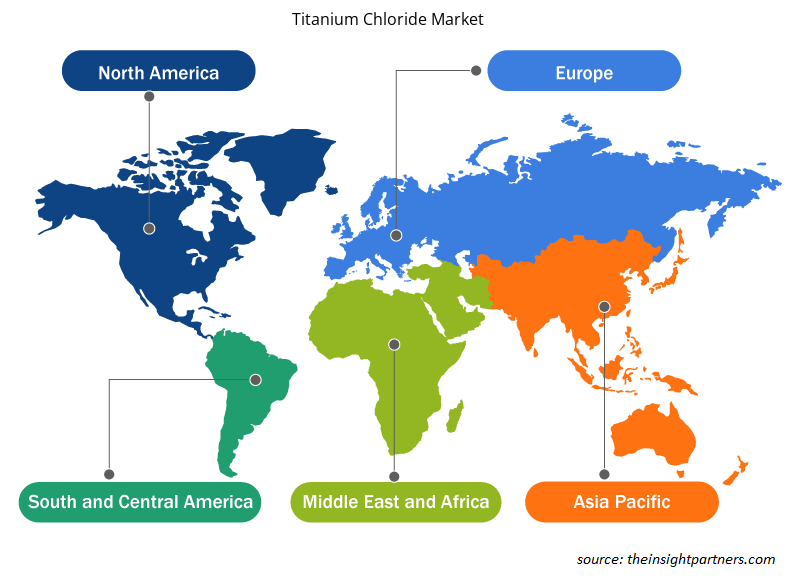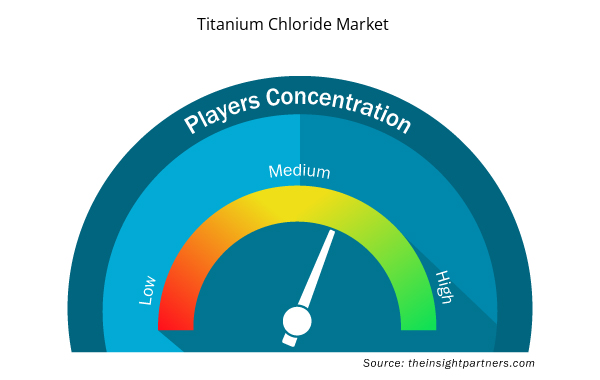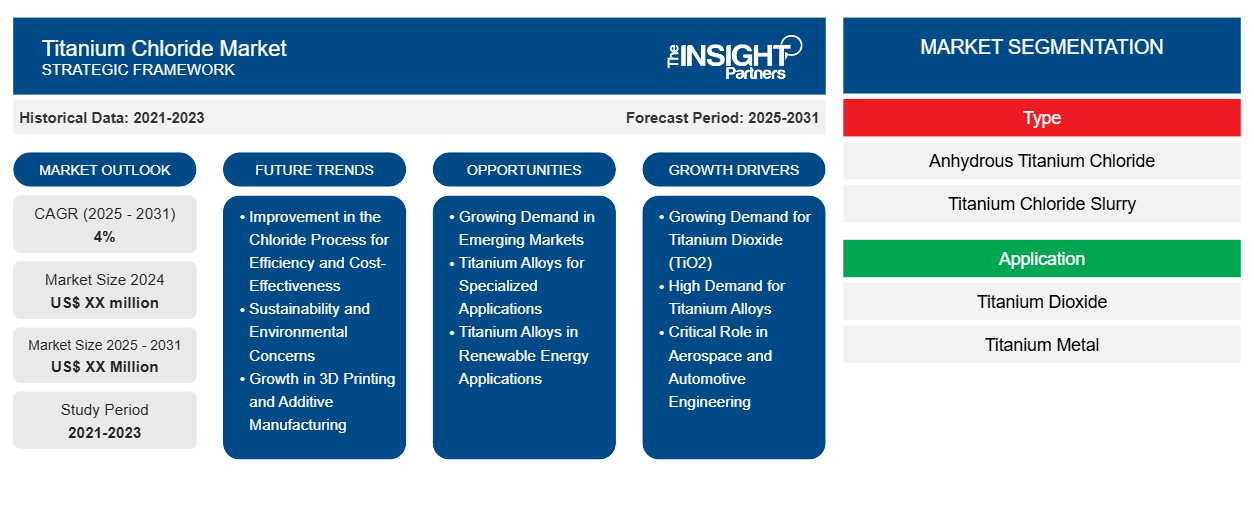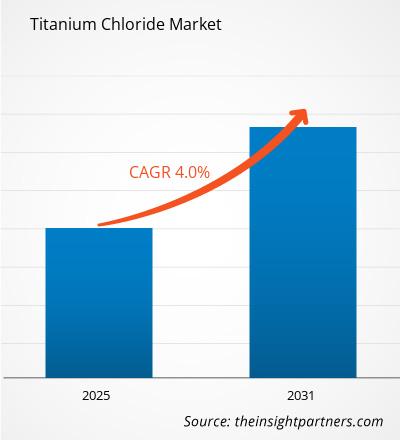Si prevede che il mercato del cloruro di titanio registrerà un CAGR del 4% dal 2024 al 2031, con una dimensione di mercato in espansione da XX milioni di dollari USA nel 2024 a XX milioni di dollari USA entro il 2031.
Il rapporto di mercato del cloruro di titanio è segmentato per tipo (cloruro di titanio anidro, poltiglia di cloruro di titanio e altri). Il mercato è segmentato in base all'applicazione (biossido di titanio, titanio metallico e altri). Il mercato è segmentato in base al settore di utilizzo finale (aerospaziale e difesa, automobilistico, medico e sanitario, beni di consumo, energia e altri). Le dimensioni e le previsioni del mercato a livello globale, regionale e nazionale per tutti i segmenti di mercato chiave sono coperte nell'ambito. Il rapporto offre il valore in USD per l'analisi, i segmenti, le regioni e i paesi di cui sopra. Il rapporto copre le tendenze di mercato, nonché le dinamiche di mercato come driver, vincoli e opportunità chiave. Il rapporto copre anche il panorama del settore e l'analisi della concorrenza che copre la concentrazione del mercato, l'analisi della mappa di calore, i principali attori e gli sviluppi recenti nel mercato.
Scopo del rapporto
Il report Titanium Chloride Market di The Insight Partners mira a descrivere il panorama attuale e la crescita futura, i principali fattori trainanti, le sfide e le opportunità. Ciò fornirà spunti a vari stakeholder aziendali, come:
- Fornitori/produttori di tecnologia: per comprendere le dinamiche di mercato in evoluzione e conoscere le potenziali opportunità di crescita, consentendo loro di prendere decisioni strategiche informate.
- Investitori: condurre un'analisi completa delle tendenze in merito al tasso di crescita del mercato, alle proiezioni finanziarie del mercato e alle opportunità esistenti lungo la catena del valore.
- Enti di regolamentazione: regolamentano le politiche e le attività di controllo sul mercato allo scopo di ridurre al minimo gli abusi, preservare la fiducia degli investitori e sostenere l'integrità e la stabilità del mercato.
Segmentazione del mercato del cloruro di titanio
Tipo
- Cloruro di titanio anidro
- Fango di cloruro di titanio
Applicazione
- Biossido di titanio
- Metallo di titanio
Settore di utilizzo finale
- Aerospaziale e difesa
- Automobilistico
- Medicina e assistenza sanitaria
- Beni di consumo
- Energia
Geografia
- America del Nord
- Europa
- Asia-Pacifico
- America del Sud e Centro
- Medio Oriente e Africa
Personalizza questo report in base alle tue esigenze
Riceverai la personalizzazione gratuita di qualsiasi report, comprese parti di questo report, o analisi a livello nazionale, pacchetto dati Excel, oltre a usufruire di grandi offerte e sconti per start-up e università
- Scopri le principali tendenze di mercato in questo rapporto.Questo campione GRATUITO includerà analisi di dati che spaziano dalle tendenze di mercato alle stime e alle previsioni.
Fattori di crescita del mercato del cloruro di titanio
- Domanda crescente di biossido di titanio (TiO2): una delle materie prime più vitali per la produzione di biossido di titanio (TiO2) è il cloruro di titanio. Il TiO2 è ampiamente diffuso in molti settori, tra cui vernici, rivestimenti, materie plastiche e cosmetici. La crescente domanda di pigmenti bianchi e di agenti bloccanti dai raggi ultravioletti che utilizzano il TiO2 verrà assorbita dal mercato globale. Una parte importante dei numerosi processi industriali e di consumo è stata dedicata alla produzione di TiCl, in quanto costituisce un'importante operazione chimica per esso.
- Elevata domanda di leghe di titanio: le leghe di titanio sono leghe ad alta domanda che hanno applicazioni in diversi settori come l'aerospaziale, i dispositivi medici e la produzione, dove le scarse proprietà meccaniche nelle parti finali possono causare danni ai loro usi. Produce metallo di titanio ad alta purezza, che funge da importante materia prima per la produzione di leghe di titanio. La domanda delle industrie di tanto in tanto includerebbe una formazione più avanzata di leghe a base di titanio per applicazioni specifiche come negli impianti medici o nelle parti di aeromobili per avere una domanda crescente di cloruro di titanio come uno degli input crescenti per la sua produzione.
- Ruolo critico nell'ingegneria aerospaziale e automobilistica: la materia prima per la produzione di metalli di titanio altamente puri, le cui applicazioni sono nell'ingegneria aerospaziale, della difesa e automobilistica, è il cloruro di titanio. Il titanio ha un eccellente rapporto resistenza/peso, resistenza alla corrosione e stabilità alle alte temperature, il che lo rende importante per queste applicazioni ingegneristiche. I materiali richiesti per lavorare in queste condizioni sono molto leggeri e resistenti e saranno un fattore trainante molto significativo per il consumo di cloruro di titanio come precursore del titanio per la produzione di ingegneria aerospaziale e automobilistica.
Tendenze future del mercato del cloruro di titanio
- Miglioramento del processo del cloruro per efficienza e convenienza: il processo del cloruro è essenzialmente il processo impiegato per produrre biossido di titanio (TiO2), nonché metallo di titanio ad alta purezza. Data la crescente domanda di prodotto di biossido di titanio insieme alla domanda di leghe di titanio, il miglioramento del processo del cloruro per efficienza e convenienza è apparso molto imminente. Le innovazioni in metodi di estrazione più efficienti e migliori tecniche di purificazione guideranno il mercato del cloruro di titanio. Come previsto, questi miglioramenti ridurranno i costi, avranno un impatto ambientale minore e miglioreranno effettivamente le capacità produttive complessive.
- Sostenibilità e preoccupazioni ambientali: per tenere il passo con questa marcia mondiale in molti settori industriali verso la sostenibilità, l'attenzione è ora più facilmente incline ad avere un impatto ambientale minore nella produzione di cloruro di titanio. L'uso di cloro e carbonio ad alte temperature comporta anche emissioni di carbonio nella produzione di tali cloruri di titanio. La tecnologia continuerà a svilupparsi per maggiori riduzioni nell'uso di carbonio durante la produzione di cloruro di titanio mediante metodi più puliti e un riciclaggio migliorato. Ciò includerebbe cose come l'uso di energie rinnovabili nei processi di produzione e il rendere l'intero processo di produzione di cloruri di titanio più ecologico.
- Crescita nella stampa 3D e nella produzione additiva: ha trovato impiego nella produzione di polvere di titanio di alta qualità, e questa polvere viene ulteriormente sintetizzata nelle tecnologie di stampa 3D e produzione additiva. Man mano che sempre più aziende aerospaziali, automobilistiche e sanitarie si stanno gradualmente avvicinando alla produzione parzialmente additiva, la domanda di queste polveri aumenterà sicuramente. Questa recente tendenza ha aperto molte strade per il mercato del cloruro di titanio perché ha molto bisogno di polveri di titanio ad alta purezza e uniformi da preparare per applicazioni di stampa 3D.
Opportunità di mercato del cloruro di titanio
- Domanda crescente nei mercati emergenti: i mercati emergenti di Cina, India e Brasile stanno assistendo a una domanda crescente di cloruro di titanio a seguito dell'industrializzazione, dello sviluppo infrastrutturale e delle maggiori attività manifatturiere in questi paesi. Ecco perché oggi si stanno concentrando sulla creazione di settori aerospaziali, automobilistici e della difesa più forti, che serviranno ad aumentare ulteriormente il consumo di cloruro di titanio nella produzione di titanio ad alta purezza. Quindi, gli schemi ottimali delle aziende potrebbero essere la creazione di stabilimenti di produzione, partnership e reti di distribuzione in questi paesi in modo che possano trarre profitto dalla crescita di queste regioni.
- Leghe di titanio per applicazioni specializzate: il cloruro di titanio è quindi un importante prodotto chimico nella produzione di titanio metallico iperelementare, che viene utilizzato per ottenere meravigliose leghe di titanio. Esistono ampie opportunità nella produzione di leghe specializzate di titanio destinate a nuovi settori come gli impianti medici, l'energia e l'elettronica. La forte domanda di materiali in grado di resistere a temperature estreme, pressione e corrosione di ambienti come quelli utilizzati nell'energia e nella tecnologia medica stimolerà un ulteriore utilizzo del cloruro di titanio nelle leghe.
- Leghe di titanio nelle applicazioni di energia rinnovabile: poiché la domanda di tali materiali avanzati è aumentata insieme alla maggiore generazione di energia rinnovabile, ha incluso anche leghe di titanio nella produzione di pannelli solari, turbine eoliche e sistemi di accumulo di energia. Tali fonti di energia rinnovabile dipendono molto dal titanio per un funzionamento efficiente. In tali applicazioni, il titanio offre componenti ad alta resistenza e basso peso che sono altamente durevoli e resistenti alla corrosione. L'uso crescente del titanio in applicazioni come celle a combustibile o accumulo di energia ha quindi un impatto sul mercato del cloruro di titanio poiché questa è la materia prima per la produzione di titanio che serve queste industrie.
Approfondimenti regionali sul mercato del cloruro di titanio
Le tendenze regionali e i fattori che influenzano il mercato del cloruro di titanio durante il periodo di previsione sono stati ampiamente spiegati dagli analisti di Insight Partners. Questa sezione discute anche i segmenti e la geografia del mercato del cloruro di titanio in Nord America, Europa, Asia Pacifico, Medio Oriente e Africa e America meridionale e centrale.

- Ottieni i dati specifici regionali per il mercato del cloruro di titanio
Ambito del rapporto di mercato del cloruro di titanio
| Attributo del report | Dettagli |
|---|---|
| Dimensioni del mercato nel 2024 | XX milioni di dollari USA |
| Dimensioni del mercato entro il 2031 | XX milioni di dollari USA |
| CAGR globale (2025 - 2031) | 4% |
| Dati storici | 2021-2023 |
| Periodo di previsione | 2025-2031 |
| Segmenti coperti | Per tipo
|
| Regioni e Paesi coperti | America del Nord
|
| Leader di mercato e profili aziendali chiave |
|
Densità degli attori del mercato del cloruro di titanio: comprendere il suo impatto sulle dinamiche aziendali
Il mercato del cloruro di titanio sta crescendo rapidamente, spinto dalla crescente domanda degli utenti finali dovuta a fattori quali l'evoluzione delle preferenze dei consumatori, i progressi tecnologici e una maggiore consapevolezza dei benefici del prodotto. Con l'aumento della domanda, le aziende stanno ampliando le loro offerte, innovando per soddisfare le esigenze dei consumatori e capitalizzando sulle tendenze emergenti, il che alimenta ulteriormente la crescita del mercato.
La densità degli operatori di mercato si riferisce alla distribuzione di aziende o società che operano in un particolare mercato o settore. Indica quanti concorrenti (operatori di mercato) sono presenti in un dato spazio di mercato in relazione alle sue dimensioni o al valore di mercato totale.
Le principali aziende che operano nel mercato del cloruro di titanio sono:
- Cangzhou Heli Chemical Co., Ltd.
- CRISTALLO
- ISHIHARA SANGYO KAISHA, LTD.
- KRONOS Worldwide, Inc.
- Azienda: OSAKA Titanium Technologies Co.,Ltd.
Disclaimer : le aziende elencate sopra non sono classificate secondo un ordine particolare.

- Ottieni una panoramica dei principali attori del mercato del cloruro di titanio
Punti di forza chiave
- Copertura completa: il rapporto copre in modo completo l'analisi di prodotti, servizi, tipologie e utenti finali del mercato del cloruro di titanio, fornendo una panoramica olistica.
- Analisi degli esperti: il rapporto è compilato sulla base della conoscenza approfondita di esperti e analisti del settore.
- Informazioni aggiornate: il rapporto garantisce la pertinenza aziendale grazie alla copertura di informazioni recenti e tendenze nei dati.
- Opzioni di personalizzazione: questo report può essere personalizzato per soddisfare le esigenze specifiche del cliente e adattarsi in modo appropriato alle strategie aziendali.
Il rapporto di ricerca sul mercato del cloruro di titanio può, quindi, aiutare a guidare il percorso di decodificazione e comprensione dello scenario del settore e delle prospettive di crescita. Sebbene possano esserci alcune preoccupazioni valide, i vantaggi complessivi di questo rapporto tendono a superare gli svantaggi.
- Analisi storica (2 anni), anno base, previsione (7 anni) con CAGR
- Analisi PEST e SWOT
- Valore/volume delle dimensioni del mercato - Globale, regionale, nazionale
- Industria e panorama competitivo
- Set di dati Excel



Report Coverage
Revenue forecast, Company Analysis, Industry landscape, Growth factors, and Trends

Segment Covered
This text is related
to segments covered.

Regional Scope
North America, Europe, Asia Pacific, Middle East & Africa, South & Central America

Country Scope
This text is related
to country scope.
Domande frequenti
Advancements in chloride process technology are expected to be the key market trends.
Based on end-use industry, the energy segment is expected to witness the fastest growth during the forecast period.
Based on geography, Asia Pacific held the largest share of the titanium chloride market due to the strong growth of the automotive and energy sector in the region.
Growth in titanium dioxide (TiO2) production are driving the market growth.
Huntsman Corporation, Chemours Company, Kronos Worldwide Inc, Lomon Billions Group, Iluka Resources Limited, Tronox Holdings, Taiwan Semiconductor Manufacturing Company, Zhejiang Materials Industry Group, Shandong Dongjia Group, and Valence Surface Technologies are the key players operating in the titanium chloride market.
The Titanium Chloride Market is estimated to witness a CAGR of 4% from 2023 to 2031
Trends and growth analysis reports related to Chemicals and Materials : READ MORE..
1. Cangzhou Heli Chemical Co., Ltd.
2. CRISTAL
3. ISHIHARA SANGYO KAISHA, LTD.
4. KRONOS Worldwide, Inc.
5. OSAKA Titanium Technologies Co.,Ltd.
6. The Chemours Company
7. TOHO TITANIUM CO., LTD.
8. Tronox Limited
9. Venator Materials PLC.
10. Xiantao Zhongxing Electronic Materials Co., Ltd.
The Insight Partners performs research in 4 major stages: Data Collection & Secondary Research, Primary Research, Data Analysis and Data Triangulation & Final Review.
- Data Collection and Secondary Research:
As a market research and consulting firm operating from a decade, we have published and advised several client across the globe. First step for any study will start with an assessment of currently available data and insights from existing reports. Further, historical and current market information is collected from Investor Presentations, Annual Reports, SEC Filings, etc., and other information related to company’s performance and market positioning are gathered from Paid Databases (Factiva, Hoovers, and Reuters) and various other publications available in public domain.
Several associations trade associates, technical forums, institutes, societies and organization are accessed to gain technical as well as market related insights through their publications such as research papers, blogs and press releases related to the studies are referred to get cues about the market. Further, white papers, journals, magazines, and other news articles published in last 3 years are scrutinized and analyzed to understand the current market trends.
- Primary Research:
The primarily interview analysis comprise of data obtained from industry participants interview and answers to survey questions gathered by in-house primary team.
For primary research, interviews are conducted with industry experts/CEOs/Marketing Managers/VPs/Subject Matter Experts from both demand and supply side to get a 360-degree view of the market. The primary team conducts several interviews based on the complexity of the markets to understand the various market trends and dynamics which makes research more credible and precise.
A typical research interview fulfils the following functions:
- Provides first-hand information on the market size, market trends, growth trends, competitive landscape, and outlook
- Validates and strengthens in-house secondary research findings
- Develops the analysis team’s expertise and market understanding
Primary research involves email interactions and telephone interviews for each market, category, segment, and sub-segment across geographies. The participants who typically take part in such a process include, but are not limited to:
- Industry participants: VPs, business development managers, market intelligence managers and national sales managers
- Outside experts: Valuation experts, research analysts and key opinion leaders specializing in the electronics and semiconductor industry.
Below is the breakup of our primary respondents by company, designation, and region:

Once we receive the confirmation from primary research sources or primary respondents, we finalize the base year market estimation and forecast the data as per the macroeconomic and microeconomic factors assessed during data collection.
- Data Analysis:
Once data is validated through both secondary as well as primary respondents, we finalize the market estimations by hypothesis formulation and factor analysis at regional and country level.
- Macro-Economic Factor Analysis:
We analyse macroeconomic indicators such the gross domestic product (GDP), increase in the demand for goods and services across industries, technological advancement, regional economic growth, governmental policies, the influence of COVID-19, PEST analysis, and other aspects. This analysis aids in setting benchmarks for various nations/regions and approximating market splits. Additionally, the general trend of the aforementioned components aid in determining the market's development possibilities.
- Country Level Data:
Various factors that are especially aligned to the country are taken into account to determine the market size for a certain area and country, including the presence of vendors, such as headquarters and offices, the country's GDP, demand patterns, and industry growth. To comprehend the market dynamics for the nation, a number of growth variables, inhibitors, application areas, and current market trends are researched. The aforementioned elements aid in determining the country's overall market's growth potential.
- Company Profile:
The “Table of Contents” is formulated by listing and analyzing more than 25 - 30 companies operating in the market ecosystem across geographies. However, we profile only 10 companies as a standard practice in our syndicate reports. These 10 companies comprise leading, emerging, and regional players. Nonetheless, our analysis is not restricted to the 10 listed companies, we also analyze other companies present in the market to develop a holistic view and understand the prevailing trends. The “Company Profiles” section in the report covers key facts, business description, products & services, financial information, SWOT analysis, and key developments. The financial information presented is extracted from the annual reports and official documents of the publicly listed companies. Upon collecting the information for the sections of respective companies, we verify them via various primary sources and then compile the data in respective company profiles. The company level information helps us in deriving the base number as well as in forecasting the market size.
- Developing Base Number:
Aggregation of sales statistics (2020-2022) and macro-economic factor, and other secondary and primary research insights are utilized to arrive at base number and related market shares for 2022. The data gaps are identified in this step and relevant market data is analyzed, collected from paid primary interviews or databases. On finalizing the base year market size, forecasts are developed on the basis of macro-economic, industry and market growth factors and company level analysis.
- Data Triangulation and Final Review:
The market findings and base year market size calculations are validated from supply as well as demand side. Demand side validations are based on macro-economic factor analysis and benchmarks for respective regions and countries. In case of supply side validations, revenues of major companies are estimated (in case not available) based on industry benchmark, approximate number of employees, product portfolio, and primary interviews revenues are gathered. Further revenue from target product/service segment is assessed to avoid overshooting of market statistics. In case of heavy deviations between supply and demand side values, all thes steps are repeated to achieve synchronization.
We follow an iterative model, wherein we share our research findings with Subject Matter Experts (SME’s) and Key Opinion Leaders (KOLs) until consensus view of the market is not formulated – this model negates any drastic deviation in the opinions of experts. Only validated and universally acceptable research findings are quoted in our reports.
We have important check points that we use to validate our research findings – which we call – data triangulation, where we validate the information, we generate from secondary sources with primary interviews and then we re-validate with our internal data bases and Subject matter experts. This comprehensive model enables us to deliver high quality, reliable data in shortest possible time.


 Ottieni un campione gratuito per questo repot
Ottieni un campione gratuito per questo repot